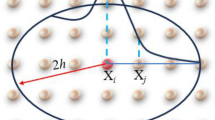Abstract
Through investigating the diamond-silicon grinding system, the grinding mechanism, including chip removal and subsurface damage, is discussed with the aid of the molecular dynamics (MD) approach and grinding experiments. Based on MD simulation, nanometric-grinding mechanism is analyzed from the viewpoint of instantaneous distribution of atoms, grinding force, and the potential energy between atoms and the profile of the groove. The simulation results show that some silicon atoms are deformed and piled up in front and on two sides of the abrasive surface because of the extrusion and cutting. When the energy in silicon lattice reaches its maximum value, the bonds of silicon atoms are broken and the material is removed. With the advancement of the abrasive, the silicon lattice under the abrasive surface is fractured, and then the amorphous layers are formed and propagated, which causes the subsurface damage. At the same time, some amorphous atoms are reconstructed and the degenerating layer of the machined surface is formed. Besides, the recovery of elatstic deformation occurs in the machined surface of the workpiece. In addition, the grinding experiment and profile detection with the aid of the measurement for 3D profiling are performed to verify the simulation results. The good agreement in the profile of the groove between the experimental value and the simulating value shows that MD simulation is very effective and reliable, and successful to fulfill the investigation on nanometric machining mechanism.
Similar content being viewed by others
References
Shimada S, Ikawa N, Tanaka H. Feasibility study on ultimate accuracy in microcutting using molecular dynamics simulation. Annals of the CIRP, 1993, 42(1): 91–94
Luo Xichun, Liang Yingchun, Dong Shen. Molecular dynamics study on cutting mechanism of defect-free monocrystalline silicon. Aviation Precision Manufacturing Technology, 2000, 36: 21–24 (in Chinese)
Zhang L C, Tanaka H. On the mechanics and physics in the nano-indentation of silicon monocrystals. JSME, 1999, 42(4): 546–559
Zarudi I, Zhang L C. Structure changes in mono-crystalline silicon subjected to indentation-experimental findings. Tribology, 1999, 32: 701–712
Tang Yulan. Research on cutting process and related technology of crystal material based on molecular dynamics. Dissertation for the doctoral degree in engineering, Harbin: Harbin Institute of Technology, 2004, 81–88
Shimizu J, Zhou L, Muroya A, et al. Simulation and experimental analysis of abrasive wear in ultra high-speed grinding. In: Proceedings of WTC, 2001, 3–7
Cheong W C D, Zhang L C, Tanaka H. Some essentials of simulation nano-surfacing processes using the molecular dynamics method. KEM, 2001, 196: 31–42
Tersoff J. Modeling solid-state chemistry: Interatomic potentials for multicomponent system. Physics Review B, 1989, 39: 5566–5568
Guo Xiaoguang, Guo Dongming, Kang Renke, et al. Molecular dynamics simulation in monocrystal silicon grinding. Chinese Journal of Mechanical Engineering, 2006, 42: 46–49 (in Chinese)
Author information
Authors and Affiliations
Corresponding author
Rights and permissions
About this article
Cite this article
Guo, X., Guo, D., Kang, R. et al. Theoretical and experimental analysis on super precision grinding of monocrystal silicon. Front. Mech. Eng. China 2, 137–143 (2007). https://doi.org/10.1007/s11465-007-0023-9
Received:
Accepted:
Issue Date:
DOI: https://doi.org/10.1007/s11465-007-0023-9




